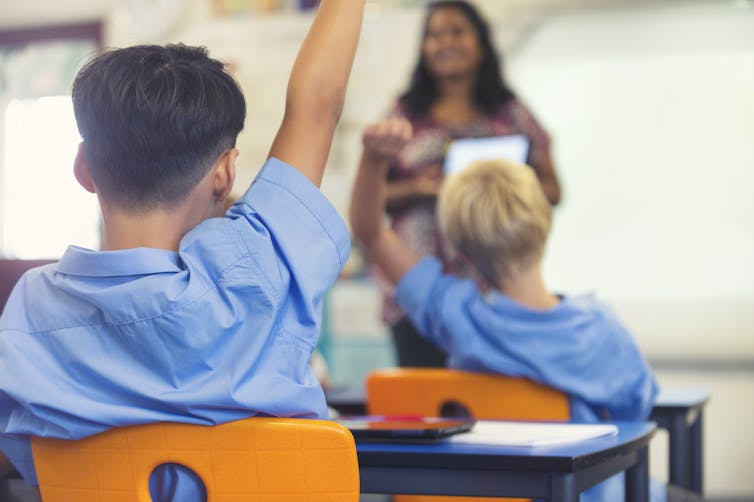How can Australia support more Aboriginal and Torres Strait Islander teachers?
- Written by Ren Perkins, PhD Candidate, School of Education, The University of Queensland

A major federal government review into how we train our teachers has just been released.
This is part of the government’s push to improve Australia’s standing in the international education rankings.
The first two recommendations focus on the important role of Indigenous teachers. Namely, specifically targeting Aboriginal and Torres Strait Islander peoples in a national recruitment campaign.
The government has a history of trying to increase the numbers of Indigenous teachers. We must build on these earlier attempts and centre the voices of Indigenous peoples in implementing programs to support these recommendations if these are to lead to successful outcomes.
Read more: Invisible language learners: what educators need to know about many First Nations children
The role of Indigenous teachers
There is no shortage of media coverage about Closing the Gap in education. Yet we hear little about the role Indigenous teachers have been playing in Indigenous education over decades.
Australia’s professional standards for teachers highlight the importance of having a teacher workforce capable of teaching Indigenous students, and teaching about Australia’s full histories and the importance of reconciliation.
Research also shows Indigenous teachers and support workers in schools bring a wealth of additional knowledges and skills to Australian schools. These knowledges can include local knowledge of Country, kinship groups, Indigenous languages, community dynamics and politics and embodied knowledges acquired through lived experiences of being an Indigenous person.
Indigenous students and indeed all Australian students benefit from seeing strong Indigenous role models in schools.
However, we also know some Indigenous teachers are encountering racism, have all Indigenous-related issues diverted to them and feel isolated.
What are the ‘gaps’?
In the last Australian Census in 2016, Indigenous students accounted for 6.2% of all students. At the same time, 2% of Australian teachers identified as Indigenous. The data clearly show there is a gap in equality between Indigenous student numbers and Indigenous teacher numbers.
Currently, there is no national database on teacher retention. The recent Australian Teacher Workforce Data report provides an insight into the difference in retention rates between Indigenous and non-Indigenous teachers. Indigenous teachers were considerably more likely to intend to leave the profession before they retired (36%), in comparison to the overall teacher workforce (25%).
These are gaps we should be focusing on in Indigenous education policy.
Past programs
The severe shortage of Indigenous teachers has been on government radars for some time. In 2011-2015 the federal government spent A$7.5 million to increase Indigenous teachers in Australian schools.
This was a large investment and the only program of its kind. It was led by three of Australia’s leading Indigenous education scholars. The number of Indigenous teachers increased by 16.5% during this initiative. This improvement demonstrates what can be achieved under Indigenous leadership.
An evaluation of the funding later found we need program reform and more policy on how to increase and retain Indigenous teachers. This includes a focus on improving graduation rates and leadership and workplace opportunities for current Indigenous teachers.
It also needs to include Indigenous teachers’ voices in understanding how to increase and retain Indigenous teachers.
But there has been limited action since this program ended in 2016 until now.
Read more: For the first time, Closing the Gap has a higher education target – here's how to achieve it
Indigenous-led research
Much of the existing research has been on Indigenous teachers leaving the profession. But a critical resource is those who have remained despite the challenges. Ren Perkins’ PhD research is looking at this group and what we can learn from them.
Through listening to Indigenous teachers, this research explores why this cohort is staying in the profession beyond the average of six years.
While the study is not yet complete, one of the key themes emerging from this research has been the strength of identity and culture.
Read more: Preschool benefits Indigenous children more than other types of early care
Jemimah* shared her perspective on how identity is connected to her role as a teacher:
I think it’s important for me to enter the field of education, to become part of the community that is Indigenous educators, in the hopes that one day, too, I can help a student find their own place in the schooling system […]
Another Indigenous teacher, Sarah, shared how her identity informs how she teaches the curriculum, enriching learning experiences for all students:
Quality teachers should know who all of your students are, but, in particular, why this subject is so important is because of where we are, whose land we’re on and what Country we’re teaching on. It’s a really important part of knowing our history and why we’ve come to this position.
What next?
The recommendations from this latest report are timely. However, more support through specific programs and funding is needed to transform these recommendations into action.
There is expertise among Indigenous peoples about how to grow the Indigenous teacher workforce – we need to listen and use it.
*Names have been changed
Authors: Ren Perkins, PhD Candidate, School of Education, The University of Queensland




